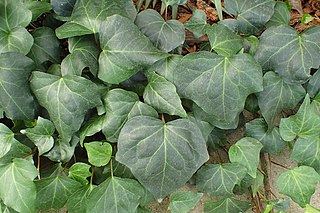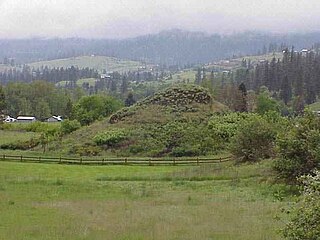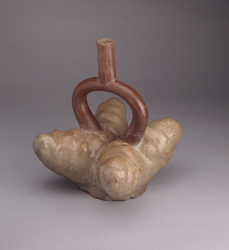
A hedge or hedgerow is a line of closely spaced shrubs and sometimes trees, planted and trained to form a barrier or to mark the boundary of an area, such as between neighbouring properties. Hedges that are used to separate a road from adjoining fields or one field from another, and are of sufficient age to incorporate larger trees, are known as hedgerows. Often they serve as windbreaks to improve conditions for the adjacent crops, as in bocage country. When clipped and maintained, hedges are also a simple form of topiary.

Quercus ilex, the holm oak, also evergreen oak, is a large evergreen oak native to the Mediterranean region. It is a member of the section Ilex of the genus, with acorns that mature in a single summer.

The lesser redpoll is a small passerine bird in the finch family, Fringillidae. It is the smallest, brownest, and most streaked of the redpolls. It is sometimes classified as a subspecies of the common redpoll but has recently been split from that species by most taxonomies including Clements and the British Ornithologists' Union. It is native to Europe and has been introduced to New Zealand. Many birds migrate further south in winter, but the mild climate means that it can be found all year round in much of its range, and may be joined by the other two redpoll species in winter.

Pinus nigra, the Austrian pine or black pine, is a moderately variable species of pine, occurring across Southern Europe from the Iberian Peninsula to the eastern Mediterranean, on the Anatolian peninsula of Turkey, Corsica and Cyprus, as well as Crimea and in the high mountains of Northwest Africa. The world's oldest black pine, located in the Banaz district of Uşak, Türkiye, is estimated to be 1000 years old. This makes it significant in the country, which is known for a very dry climate, inhospitable for most trees. It has a length of 11 meters, a diameter of 3 meters and a circumference of 9.60 meters.

Hedera, commonly called ivy, is a genus of 12–15 species of evergreen climbing or ground-creeping woody plants in the family Araliaceae, native to Western Europe, Central Europe, Southern Europe, Macaronesia, northwestern Africa and across central-southern Asia east to Japan and Taiwan. Several species are cultivated as climbing ornamentals, and the name ivy especially denotes common ivy, known in North America as "English ivy", which is frequently planted to clothe brick walls.

Aegopodium podagraria, commonly called ground elder, is a species of flowering plant in the carrot family Apiaceae that grows in shady places. The name "ground elder" comes from the superficial similarity of its leaves and flowers to those of elder (Sambucus), which is not closely related. Other common names include herb gerard, bishop's weed, goutweed, gout wort, snow-in-the-mountain, English masterwort and wild masterwort. It is the type species of the genus Aegopodium. It is native to Europe and Asia, but has been introduced around the world as an ornamental plant, where it occasionally poses an ecological threat as an invasive exotic plant.

Heracleum mantegazzianum, commonly known as giant hogweed, is a monocarpic perennial herbaceous plant in the carrot family Apiaceae. H. mantegazzianum is also known as cartwheel-flower, giant cow parsley, giant cow parsnip, or hogsbane. In New Zealand, it is also sometimes called wild parsnip or wild rhubarb.

Tsuga canadensis, also known as eastern hemlock, eastern hemlock-spruce, or Canadian hemlock, and in the French-speaking regions of Canada as pruche du Canada, is a coniferous tree native to eastern North America. It is the state tree of Pennsylvania. Eastern hemlocks are widespread throughout much of the Great Lakes region, the Appalachian Mountains, the Northeastern United States, and Maritime Canada. They have been introduced in the United Kingdom and mainland Europe, where they are used as ornamental trees.

Indigenous peoples of the Northwest Plateau, also referred to by the phrase Indigenous peoples of the Plateau, and historically called the Plateau Indians are Indigenous peoples of the Interior of British Columbia, Canada, and the non-coastal regions of the Northwestern United States.

Elodea canadensis is a perennial aquatic plant, or submergent macrophyte, native to most of North America. It has been introduced widely to regions outside its native range and was first recorded from the British Isles in about 1836.

Chenopodium vulvaria, stinking goosefoot is a foul-smelling plant that grows on bare ground in coastal habitats in the Mediterranean region and is associated with dung heaps and disturbed ground inland. It is native to southern Europe and western Asia and has spread to northern Europe other temperate parts of the world, with agriculture.

Rhododendron ponticum, called common rhododendron or pontic rhododendron, is a species of flowering plant in the Rhododendron genus of the heath family Ericaceae. It is native to the Iberian Peninsula in southwest Europe and the Caucasus region in northern West Asia.

Rosa pimpinellifolia, the burnet rose, is a species of rose native to western, central and southern Europe and northwest Africa.

Sisymbrium irio, London rocket, is a flowering plant in the cabbage family which is native to the Middle East, north Africa and southern Europe, and which has spread widely around the world as an invasive plant of dry, disturbed land in towns, deserts and farmland. It has traditionally been used as a medicinal herb for a variety of ailments. Its English common name originated when it flourished after the Great Fire of London in 1666, although it is not native to Britain and it does not tend to persist there.

Lathyrus aphaca, known as the yellow pea or yellow vetchling, is an annual species in the family Fabaceae with yellow flowers and solitary, pea-like fruits. It originated in the Middle East and has spread throughout Europe and beyond as a weed of cultivated fields and roadsides. The fruits are eaten as a supplement to diets in some parts of South Asia but are narcotic and potentially toxic in large quantities.

Equisetum telmateia, the great horsetail, is a species of Equisetum (horsetail) native to Europe, western Asia and northwest Africa. It was formerly widely treated in a broader sense including a subspecies in western North America, but this is now treated as a separate species, Equisetum braunii.

Epilobium hirsutum is a flowering plant belonging to the willowherb genus Epilobium in the family Onagraceae. It is commonly known as the great willowherb, great hairy willowherb or hairy willowherb. Local names include codlins-and-cream, apple-pie and cherry-pie.

Islands, such as the British Isles, can be adversely affected by the introduction of non-native species. Often an island will have several distinct species not present on the nearest mainland, and vice versa. The native flora and fauna of islands which have been isolated for a longer period of time such as New Zealand or Hawaii are more vulnerable than islands such as Great Britain and Ireland, which became isolated more recently.

The potato was the first domesticated vegetable in the region of modern-day southern Peru and extreme northwestern Bolivia between 8000 and 5000 BC. Cultivation of potatoes in South America may go back 10,000 years, but tubers do not preserve well in the archaeological record, making identification difficult. The earliest archaeologically verified potato tuber remains have been found at the coastal site of Ancón, dating to 2500 BC. Aside from actual remains, the potato is also found in the Peruvian archaeological record as a design influence of ceramic pottery, often in the shape of vessels. The potato has since spread around the world and has become a staple crop in most countries.




















